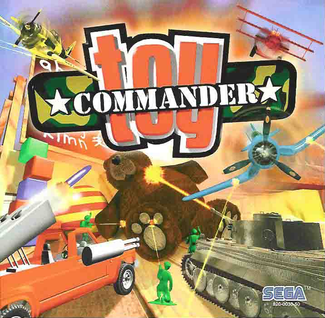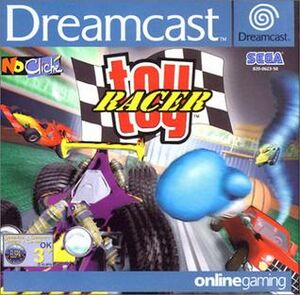Toy Commander facts for kids
Quick facts for kids Toy Commander |
|
|---|---|
 |
|
| Developer(s) | No Cliché |
| Publisher(s) | Sega |
| Director(s) | Frédérick Raynal |
| Producer(s) | Frantz Cournil |
| Designer(s) | Lionel Chaze Didier Quentin |
| Programmer(s) | Serge Plagnol Frantz Cournil |
| Artist(s) | Didier Chanfray |
| Composer(s) | Philippe Vachey |
| Platform(s) | Dreamcast |
| Release date(s) | |
| Genre(s) | Action, adventure |
| Mode(s) | Single-player, multiplayer |
Toy Commander is an exciting action game made for the Dreamcast console. It was created by a company called No Cliché and released by Sega. The game lets you control toy vehicles and complete fun missions around a house.
A version of the game for Microsoft Windows computers was planned. It was almost finished in 2001. However, it was never released because No Cliché closed down the next year.
Contents
Game Story: Toys Take Over the House
The story of Toy Commander is about a child named Andy. For Christmas, Andy gets many new army-themed toys. Because of these new toys, he starts to ignore his old favorite toys.
His old toys, led by Huggy Bear, who is Andy's childhood teddy bear, decide to rebel. They want to destroy the new toys. Each main enemy in the game is one of Huggy Bear's generals. These generals have taken over different areas of the house.
How to Play: Missions and Vehicles
In Toy Commander, you complete missions by controlling different toy vehicles. These missions happen in various rooms of a house. The game is known for its unique tasks that fit each household area.
For example, the first mission is in the kitchen. It's a training level where you learn to switch between vehicles. You can use a helicopter, a pick-up truck, and a plane. Another mission might have you using a toy car. You might need to roll eggs into a pot of boiling water.
Types of Toy Vehicles
The game has five main types of toy vehicles you can play with:
- Race cars: These are mostly used for racing missions. Sometimes you use them to navigate mazes.
- Armed ground vehicles: These include tanks or trucks with rocket launchers. They are used for combat.
- Airplanes: You can fly planes for air missions.
- Helicopters: These are also used for flying missions.
- Transport vehicles: These toys are unarmed. They are used to carry smaller toys around.
Some vehicles, like the unarmed and transport ones, can only be used in the single-player mode.
Multiplayer Fun
Toy Commander also has a battle mode for multiple players. Up to four players can play together. However, you cannot play this game online.
Game Creation: How Toy Commander Was Made
The idea for Toy Commander came from Didier Chanfray and Frédérick Raynal. Didier was the artistic director, and Frédérick was the creative director. They first thought about flying small planes and fighting inside a house.
Then, they added the idea of many small missions. These missions would have different ways to play and use different vehicles. Finally, the story about the toys rebelling was added to the game.
David Chomard, the game's executive producer, said they tried to avoid being compared to the movie Toy Story. However, he admitted they were big fans of Micro Machines. They used Micro Machines as an example of a good game with small cars.
Later, programmer Frantz Cournil mentioned that Didier Chanfray loved the Toy Story movie. This made him want to create a game where everyone could remember playing with toys in their house.
No Cliché: The Game Developers
 |
|
| Subsidiary | |
| Industry | Video games |
| Fate | Dissolved |
| Predecessor | Adeline Software International |
| Founded | 1999 |
| Defunct | 2001 |
| Headquarters | France |
|
Key people
|
Frédérick Raynal |
| Products | Toy Commander Toy Racer |
| Parent | Sega |
No Cliché was a game development company based in France. They made games for the Dreamcast console. The company was led by French developer Frédérick Raynal. The main team members had worked together before at a company called Adeline Software International. Sega later bought this team.
No Cliché was best known for its first Dreamcast game, Toy Commander, released in 1999. In 2000, they also made Toy Racer. They helped another company, Raster Productions, with the European release of Quake III Arena for Dreamcast.
In 2001, Sega Europe stopped developing many Dreamcast games. This caused No Cliché to stop working on their game Agartha, a survival horror game. The team stayed together for a short time after this. They tried to create a PC version of Toy Commander. However, the group split up before it was finished. No Cliché eventually closed down.
Game Legacy: Demos and Spin-offs
No Cliché created special demo versions of Toy Commander. One was a Christmas-themed demo called "Toy Commander: Christmas Surprise." It was released exclusively for Official Dreamcast Magazine in their Holiday 2000 issues.
Another special demo was summer-themed. It was called "Toy Commander: Summer Special." This demo also appeared in special issues of Official Dreamcast Magazine.
A spin-off game, called Toy Racer, was released in Europe on December 22, 2000. It was also made by No Cliché and published by Sega for the Dreamcast. Toy Racer was like an expansion to Toy Commander, focusing on its racing parts. It was designed only for multiplayer modes, both offline and online, for up to four players.
Because it was mostly multiplayer, Toy Racer did not have computer-controlled players. The only single-player options were a practice mode and a time attack mode. Toy Racer was only released in Europe at a low price. It did not sell as well as Toy Commander. It used similar toys and rooms from the original game. The online features of Toy Racer were brought back by a project called dcserv.org on December 3, 2014.
See also
 In Spanish: Toy Commander para niños
In Spanish: Toy Commander para niños


